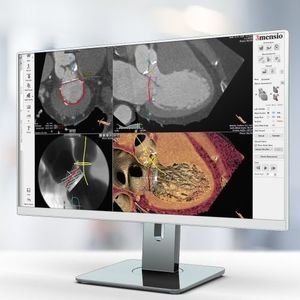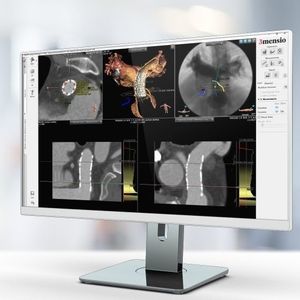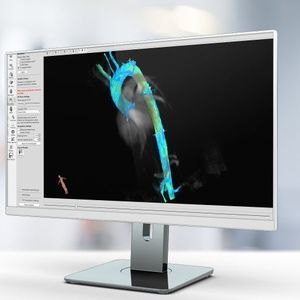
- Medical Technical Facilities
- Healthcare IT, Telemedicine
- Cardiology software
- Pie Medical Imaging
Medical software medical imagingcardiologyimage analysis

Add to favorites
Compare this product
Characteristics
- Applications
- medical, medical imaging, cardiology
- Function
- image analysis, diagnostic, measurement, treatment planning
- Area of the body
- aortic valve
- Operating system
- Windows
- Deployment mode
- for tablet PC
Description
CAAS A-Valve assists the physician in evaluating aortic regurgitation after transcatheter valve replacement.
The qRA workflow (also called videodensitometry, VD-AR, LVOT-AR) enables the physician to quantify valvular and paravalvular regurgitation immediately in the cathlab directly after placing the valve.
Clinical confidence
qRA is extensively validated by the groups of Prof. Patrick Serruys and Prof. Carl Schulz. Validation studies have been performed in:
Correlating with clinical endpoints to assess LVOT-AR cut-ff value of 0.17
Comparing with MR Flow measurements
Comparing with echocardiography measurements
Comparing with visual classification of aortic regurgitation
Phantom setup
Optimizing in cathlab workflow
To optimize in cathlab workflow the following studies been performed:
Assessing overlap free projections to optimize analyzability of aortograms:
Definition of technique for overlap free projection
ASSESS-REGURGE. A multi-center trial to assess that protocolized planning optimizes analyzability of aortograms.
Clinical Trials reference: NCT03644784
Using diastolic injections to reduce the amount of contast needed to perform qRA measurement.
CAAS A-Valve assists the physician in evaluating aortic regurgitation after transcatheter valve replacement.
The qRA workflow (also called videodensitometry, VD-AR, LVOT-AR) enables the physician to quantify valvular and paravalvular regurgitation immediately in the cathlab directly after placing the valve.
Key product features
qRA
Regurgitation Index (qRA/LVOT-AR) based on density of contrast in the aortic root and ventricle
Dynamic color map to visualize the severity and extent of regurgitation
VIDEO
Catalogs
No catalogs are available for this product.
See all of Pie Medical Imaging‘s catalogsRelated Searches
- Analysis software
- Radiology software
- Viewer software
- Tablet PC software
- Windows software
- Reporting software
- Scheduling software
- Automated software
- Diagnostic software
- Hospital software
- Treatment software
- Tracking software
- Software module
- Measurement software
- On-premise software
- Import software
- Server software
- CT software
- Cardiac software
- Image analysis software
*Prices are pre-tax. They exclude delivery charges and customs duties and do not include additional charges for installation or activation options. Prices are indicative only and may vary by country, with changes to the cost of raw materials and exchange rates.







